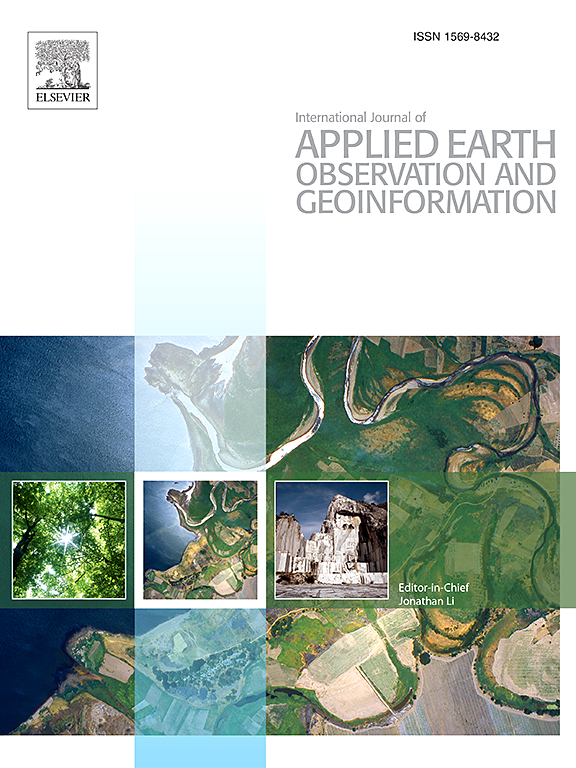Improving spatial and temporal accuracy in coastal reclamation mapping using satellite image time series
IF 7.6
Q1 REMOTE SENSING
International journal of applied earth observation and geoinformation : ITC journal
Pub Date : 2025-03-28
DOI:10.1016/j.jag.2025.104499
引用次数: 0
Abstract
Driven by urban expansion and economic growth, China has carried out extensive coastal reclamation in the past four decades, leading to negative ecological impacts. Accurate mapping of reclamation dynamics helps analyze its environmental effects and supports the government in regulating reclamation projects. Nevertheless, existing methods for monitoring coastal reclamation dynamics face two major limitations: overestimating reclamation areas and low temporal accuracy. This study proposes a novel method to automatically distinguish artificial reclamation from natural expansion to reduce the overestimation of reclaimed areas and improve temporal dynamic accuracy through time-series analysis of long-term Landsat satellite imagery. In China’s coastal regions, our method achieves an overall classification accuracy of over 94 % for artificial reclamation and natural expansion. The estimation accuracies of the year of reclamation are 91.60 % (one-year tolerance) and 96.44 % (two-year tolerance), which are more accurate than the post-classification comparison method based on the Global Surface Water (GSW) dataset. From 1990 to 2022, China’s coastal reclamation totaled 5,121.1 km2, with a slowdown after 2014 and a shift toward green development after 2018. Reclamation patterns varied regionally, with most projects concentrated in economically developed bays, driven primarily by urbanization and industrialization. The results prove that the proposed method can improve the spatiotemporal accuracy of coastal reclamation mapping, hence providing a more reliable data foundation for project siting, ecological impact assessment, and coastal management.
利用卫星影像时间序列提高填海造地制图的时空精度
在城市扩张和经济增长的推动下,中国在过去40年里进行了大规模的沿海填海,导致了负面的生态影响。准确的填海动态图有助于分析其环境影响,并为政府规范填海工程提供支持。然而,现有的海岸填海动态监测方法存在两大局限性:填海面积高估和时间精度低。本文通过对Landsat卫星长期影像的时间序列分析,提出了一种自动区分人工填海和自然扩张的新方法,以减少对填海面积的高估,提高时间动态精度。在中国沿海地区,人工填海和自然扩张的分类精度达到94%以上。复垦年份的估算精度分别为91.60%(1年误差)和96.44%(2年误差),高于基于全球地表水(GSW)数据集的分类后比较法。1990年至2022年,中国沿海填海造地总面积为5121.1平方公里,2014年后填海造地速度放缓,2018年后开始向绿色发展转变。填海模式因区域而异,大多数项目集中在经济发达的海湾,主要受城市化和工业化的推动。结果表明,该方法可提高围海填海制图的时空精度,为项目选址、生态影响评价和海岸带管理提供更可靠的数据基础。
本文章由计算机程序翻译,如有差异,请以英文原文为准。
求助全文
约1分钟内获得全文
求助全文
来源期刊

International journal of applied earth observation and geoinformation : ITC journal
Global and Planetary Change, Management, Monitoring, Policy and Law, Earth-Surface Processes, Computers in Earth Sciences
CiteScore
12.00
自引率
0.00%
发文量
0
审稿时长
77 days
期刊介绍:
The International Journal of Applied Earth Observation and Geoinformation publishes original papers that utilize earth observation data for natural resource and environmental inventory and management. These data primarily originate from remote sensing platforms, including satellites and aircraft, supplemented by surface and subsurface measurements. Addressing natural resources such as forests, agricultural land, soils, and water, as well as environmental concerns like biodiversity, land degradation, and hazards, the journal explores conceptual and data-driven approaches. It covers geoinformation themes like capturing, databasing, visualization, interpretation, data quality, and spatial uncertainty.
 求助内容:
求助内容: 应助结果提醒方式:
应助结果提醒方式:


